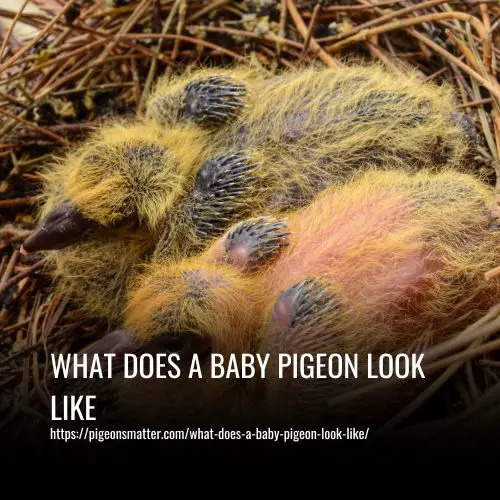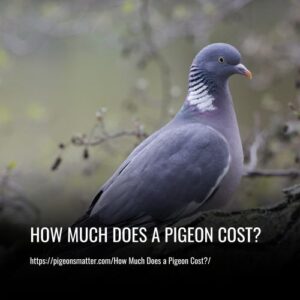A baby pigeon, also called a squab, looks very different from an adult pigeon. A baby pigeon is usually small, fluffy, and has a plump body. Its feathers are not fully developed and may be a bit downy. Baby pigeons also have a shorter beak and may have closed or partially closed eyes. As they grow, their feathers will start to come in and they will eventually resemble adult pigeons.

What Does A Juvenile Pigeon Look Like?
If you’re curious about what juvenile and fledgling pigeons look like, you may be surprised to learn that they bear a strong resemblance to adult pigeons in terms of their plumage. This is because they spend most of their time in the nest and are nearly fully grown when they first leave it. However, there are a few differences to look for.
For example, juveniles and fledglings have a pinkish-grey cere, which is distinct from the white cere of adult pigeons. Young pigeons may not possess the distinctive purple and green coloration around their necks that are present in adult birds.
Additionally, pigeons under 8 months of age typically have medium-brown or greyish-brown eyes, in contrast to the yellow, orange, or reddish-orange eyes of adults. The feathers surrounding their eyes may also appear darker than those of fully grown pigeons.
Where Are The Baby Pigeons?
It’s a common question that many people have asked. Unlike waterfowl such as ducks and geese, baby pigeons are rarely seen in most areas.
Scientists have also been curious about the frequency of sightings of young birds from different species. However, it seems that baby pigeons are just elusive creatures that prefer to stay hidden away from the public eye.
Why Are There No Baby Pigeons Around?
Baby pigeons have a longer nesting period of approximately 30 days in comparison to other bird species. When they finally leave the nest, they already resemble adult birds, making it difficult to differentiate them from their parents.
Additionally, pigeons often build their nests in hidden locations such as church towers, chimneys, and underpasses, which are not easily visible to humans. The nesting behavior of protecting nests from predators by building them on cliff faces is inherited from rock doves. Therefore, it’s not that there are no baby pigeons around, but rather that they are well hidden in their nests.
Are Baby Pigeons Real?
The question of whether baby pigeons exist may seem silly but it’s still worth exploring. While it’s true that no creature, except for one species of mites, gives birth to fully grown adult offspring, it’s also true that every bird, including pigeons, starts as a baby. Based on evolutionary principles, it is reasonable to conclude that all adult pigeons were once in the growth phase of being baby pigeons.
However, some believe in a conspiracy theory that suggests pigeons are not real and are drones. This theory suggests that only adult drones are built, which would explain why we never see baby pigeons. Despite these beliefs, science tells us that the life cycle of a pigeon is well-known and that baby pigeons do indeed exist, even if they are not as commonly seen as adult pigeons.
Why Don’t You See Baby Pigeons?
Pigeon populations are commonly found in urban areas, such as cities and large towns. However, you may have noticed that you never seem to see baby pigeons among these groups. This is because pigeon nests can be difficult to spot, as they are often built in seemingly precarious positions, such as on window ledges, scaffolding, and under bridges.
Pigeons lay two white eggs, which are incubated by both parents for 16-19 days. The male and female take turns incubating the eggs, with the male taking the day shift and the female taking the night shift. Once hatched, the baby pigeons stay in the nest for several weeks before they can fly.
Feral pigeons have adapted to living in cities, where they construct their nests on man-made structures that mimic the rocky cliffs and canyons of their natural habitat. Their nests are often flat and provide a stable surface for the eggs to rest on, so they do not require as much additional material as birds that nest in trees.
How big is a baby pigeon?
They typically measure around 5cm in length when they are first born. This is a common size for pigeon hatchlings and it’s important to note that they will grow quickly as they mature.
Keep in mind that it’s best to leave baby pigeons in the care of their parents or a wildlife rehabilitation center, as they require specialized care and feeding.
How Much Does A Baby Pigeon Weigh?
It depends on its age. Newly hatched chicks typically weigh around 15g on average. As they grow, baby pigeons gain between 4 and 8 grams per day.
By the time they reach 30 days old, their weight can range from 270 to 350 grams. So, the weight of a baby pigeon varies depending on its age and developmental stage.
When can baby pigeons fly?
If you’re wondering when baby pigeons can fly, the answer is generally around 6 weeks of age. However, they begin practicing and learning to fly from about 4 weeks old.
Observers may notice birds flapping their wings and performing small takeoffs and landings during this period.
Nest Location
Pigeons are known for building their nests in unusual locations, which could be one reason why we rarely see baby pigeons. While you may spot a few nests in trees, pigeons typically prefer to build their homes in secluded spots like on rooftops, under bridges, or against tall buildings.
In more rural areas, they may nest in caves, under rocky cliffs, or in other flat spots that provide good cover. This is because baby pigeons are vulnerable to predators like falcons, owls, and sparrowhawks, as well as animals like cats, raccoons, and snakes.
To keep their offspring safe, adult pigeons choose hidden locations where they can protect their young from these common threats. Even if a baby pigeon were to venture out of the nest, it would be well-hidden and difficult to spot.
How Long Are Baby Pigeons In The Nest?
The length of time that baby pigeons spend in the nest can vary depending on the season. During the summer months, they typically stay in the nest for around 25-32 days, while in the winter, it can be up to 45 days.
After leaving the nest, it is common for young pigeons to lose weight as they adjust to their new environment. They usually fledge a day or two before they can fly and spend some time foraging on the ground.
In certain situations, young pigeons may have trouble getting back into their nest after fledging, particularly if it is high up and they are not yet capable of flying. In these cases, they may rely on their parents and other adult pigeons to provide them with food.
What should I do if I find a baby pigeon?
If you happen to come across a baby pigeon on the ground, it’s important to follow some simple steps. If a baby pigeon falls from the nest prematurely, its parents will not recognize it and may abandon it.
If you’re able to locate the nest, carefully place the baby pigeon back inside. Don’t worry, the parents won’t mind that you’ve handled it. In situations where the nest cannot be located or if the parents are present, it is advisable to seek assistance from a wildlife rescue center. They’ll be able to provide the necessary care for the baby pigeon.
How Do Pigeons Feed Their Babies?
Pigeon parents typically return to the nest to feed their young 3 to 4 times per day. The food they bring can be either crop milk or seeds, depending on the stage of the baby’s diet. The amount of food given to each squab is consistent from day to day.
Baby pigeons signal that they are ready to eat by emitting a distinct peeping sound and lifting their heads to be fed.
After four days, they will start pushing their parents to get food. At around 7 days, the young birds will begin begging and calling for food persistently, and will generally be fed twice a day.
FAQs
Baby pigeons are initially fed crop milk, which is regurgitated by both male and female birds within 2 hours of hatching, and this continues for the first 4 days. Over the next 5 days, they are fed a combination of crop milk and seeds. By day 9, baby pigeons start to consume an adult diet, which includes seeds, fruits, and sometimes invertebrates.
As they grow, the amount of food they consume increases, especially when seeds are added to their diet. Both parents are responsible for feeding their two young ones during the first week, but after that, one adult can usually feed two squabs successfully.
Crop milk, also known as pigeon milk, is a unique substance produced by birds. It is a secretion that comes from the lining of their crop, which is a special compartment where birds can store food before it is digested.
This milk is particularly rich in fat and protein, making it an important source of nutrition for the young birds that rely on it for their growth and development.
If you’re curious about what pigeon eggs look like, they are typically small and white. They measure around 38.4mm in length and 28.6mm in width, with an average weight of 14.6g. Additionally, the eggshell thickness is around 0.18mm. This information can help you identify pigeon eggs if you come across them in your environment.
Pigeon eggs take between 16 and 19 days to hatch after being laid. The hatching process typically lasts around 24 hours and can occur at any time of day. It’s not uncommon for both eggs to hatch at the same time.
Once hatched, the parents will remove the empty eggshells from the nest. Both male and female pigeons share the responsibility of incubation, with the male incubating during mid-morning to late afternoon, and the female taking over from late afternoon to mid-morning.
Pigeons are known to breed throughout the year, which means that their eggs can hatch at any time of the year. However, the majority of baby pigeons are born during the spring and summer months.
Specifically, the peak breeding season for pigeons is between May and June, as well as between August and November.
Well, wonder no more! A baby pigeon is called a squab. A squab refers to a juvenile pigeon that is still in its developmental stage and cannot fly, usually under the age of 4 weeks.
Conclusion:
While baby pigeons may not be the most commonly seen animals, they are certainly fascinating to learn about. From their unique appearance to their incredible adaptability, these birds are a testament to the wonders of nature. And while you may not see them often, knowing what a baby pigeon looks like can help you identify these birds and appreciate them even more.
So the next time you see a pigeon, take a closer look – you may just catch a glimpse of one of these intriguing creatures.



